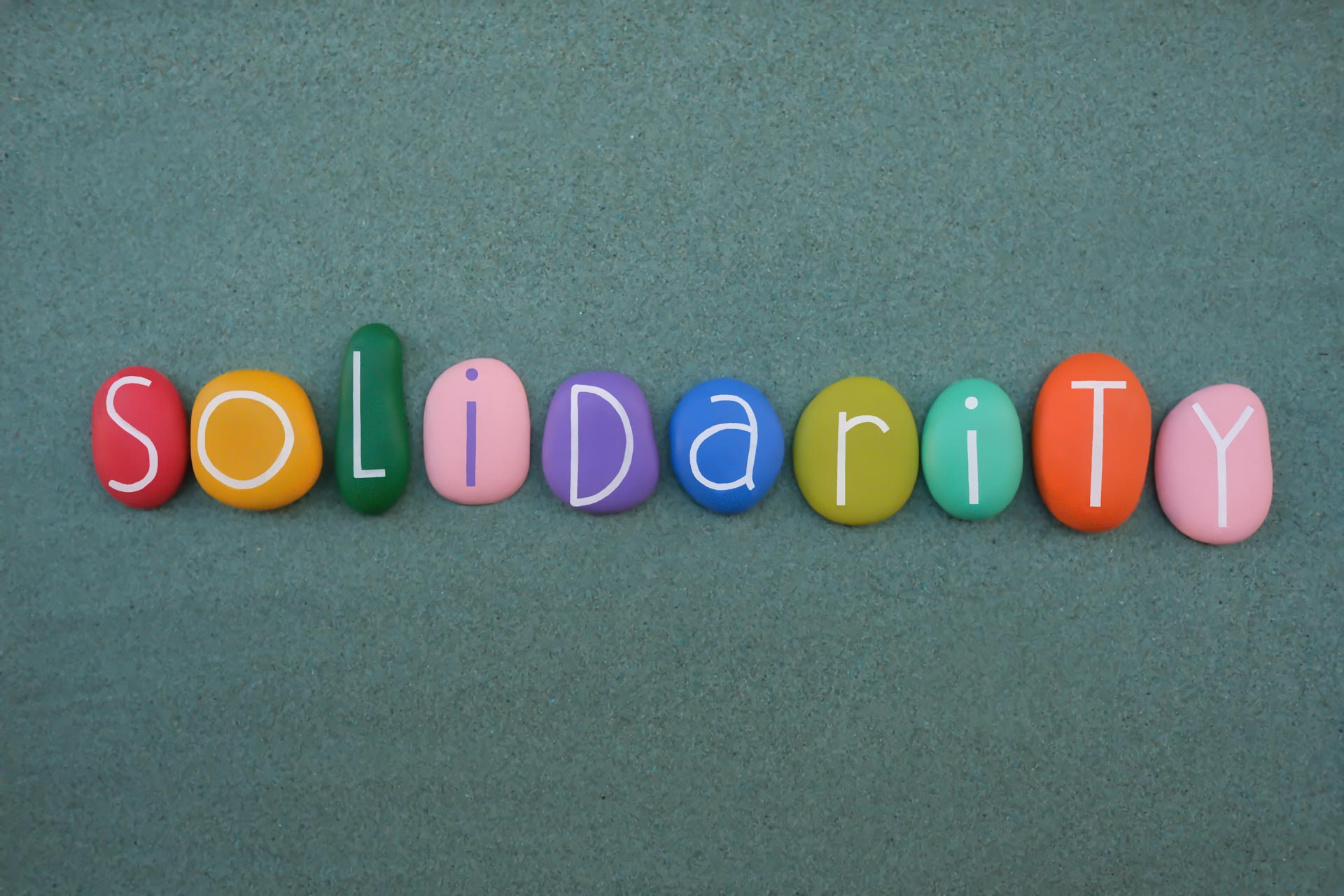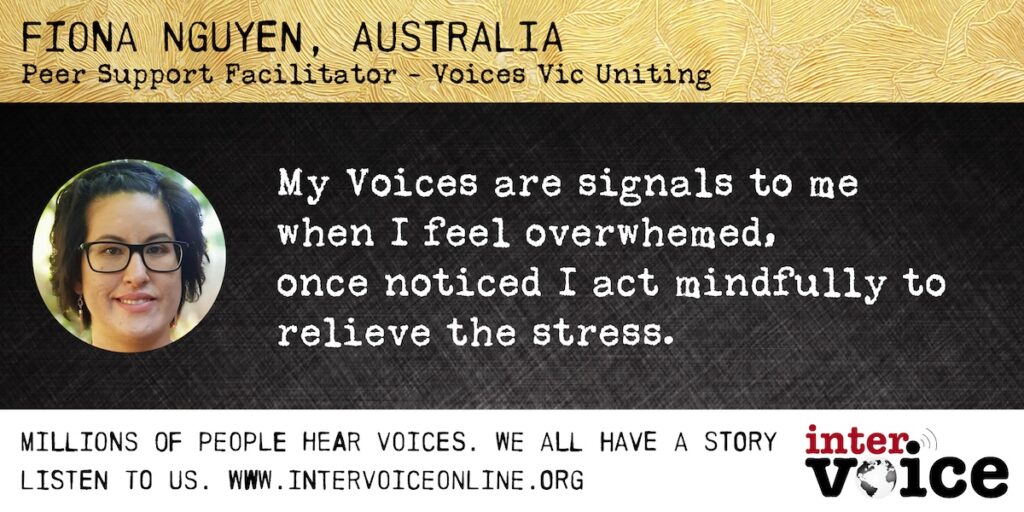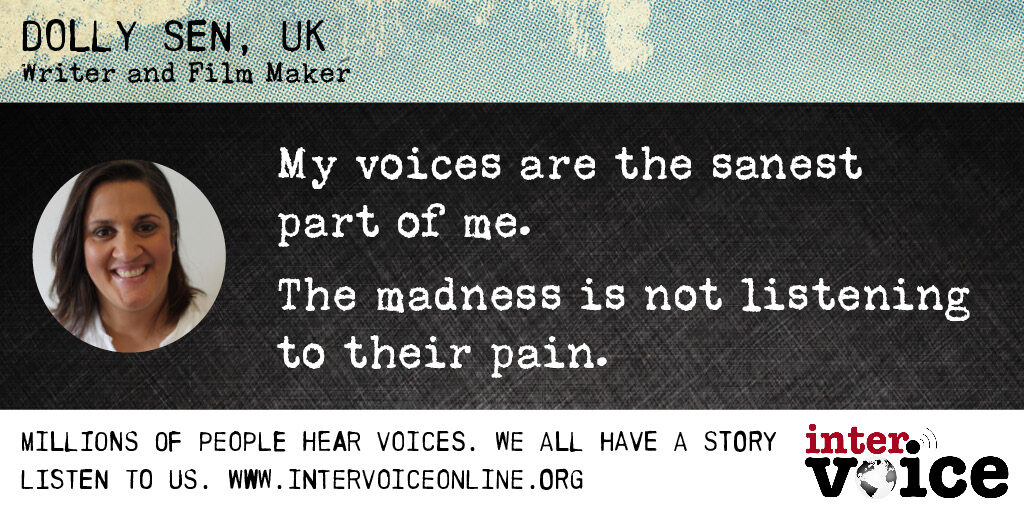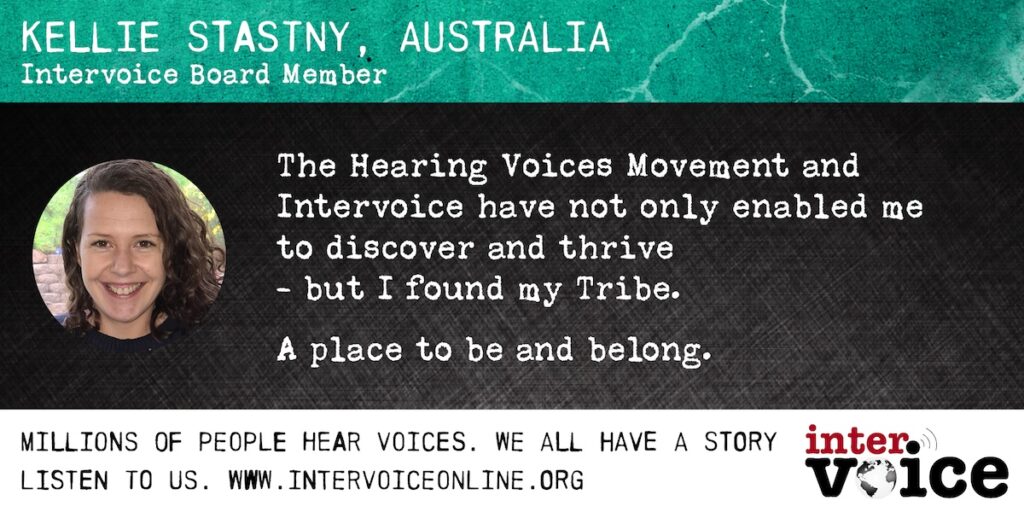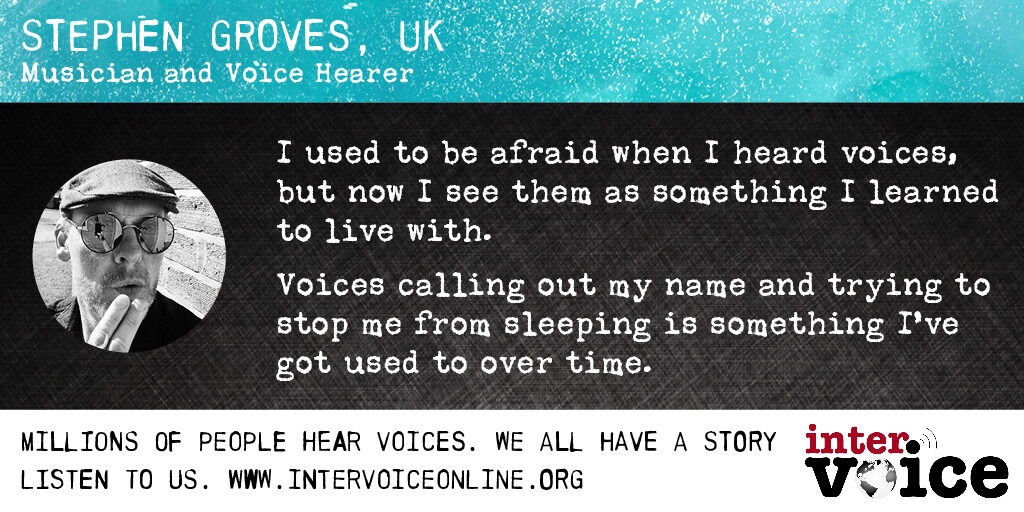Cardiff, Wales 19-21 September 2012
Introduction to the Report
This report combines accounts by a small team of people from Mind in Camden who attended the Conference and made notes on the keynote speeches and workshops. However, we were not able to cover every workshop, so programme notes were used to fill in the gaps. The notes are a summary of what was said and we have done our best to write an accurate portrayal. I apologise for any errors.
The Conference was attended by almost 300 people from many countries. It was hosted by the Hearing Voices Network, Cymru and organised by Working to Recovery and Asylum Associates. It marked the 25th anniversary of Intervoice. As well as celebrating the achievements of the past, there was much shared about current developments and, finally, looked to the future with the launch of the “One of a Million” campaign.
It was a privilege to attend such an exciting and stimulating event and I hope this report will give a flavour of that for those who were not able to be there.
Rowena Dean
November 2012
Download the full report:
2012 World Congress Report (PDF)
2012 World Congress Report (Word)
Celebrating 25 years: Intervoice Meeting 19 September
Meeting each other, exchanging experiences
Welcome and Introduction (Sandra Escher)
The Hearing Voices movement began in 1987 in the living room of Sandra Escher and Marius Romme. Sandra and Marius invited ten to twelve people to meet regularly in their home including Ron Coleman, Paul Baker and others. The group developed a strong mutual interest with some horses that were living in the garden.
Interest continued to grow and two people from each country were invited to join until the group became too big to accommodate and the meetings ended in 2007. Instead, annual international meetings began, initially alternating between the Netherlands and England.
The acceptance that voice hearing is not an illness became more common, and people were able to talk about it without the risk of them being subject to more psychiatry and more medication. Then the movement developed and “hope to cope” strategies were formed. Gradually, many more people became part of the movement.
The challenge for the future is for the movement to become broader, and as a movement, learn lessons from parallels with the gay movement: more voice hearers hopefully will start to come into the open. There is also a need to develop a group of young enthusiastic supporters.
News from the Board
The Intervoice Board met yesterday and elected four new members:
- Kellie Comans (Australia)
- Will Hall (USA)
- John Jenkins (UK)
- Eleanor Longden (UK)
The other members of the Board are:
- Dirk Corstens (Chair) (The Netherlands)
- Ron Coleman (UK)
- Jorn Erikson (Denmark)
- Sandra Escher (The Netherlands)
Intervoice has also become a registered charity.
Intervoice Meeting: Keynote Speeches
Hearing Voices and Spirituality – progress or heresy? (Hywel Davies)
Hywel said the purpose of his talk was to raise awareness and it “may be wrong or it may be right.”
Spirituality is about belief in the Divine; worship; a sense of presence; of prayer and “whatever is holy” (William Blake). Hywel quoted George Clooney, “the difference between religion and spirituality is that religion is for those who wish to avoid going to hell and spirituality is for those who have been there.”
Is it progress or heresy to include spirituality in the care of mental health care? In Wales, people have a legal right to request spiritual care as part of their mental health package. Psychiatrists have to take into account the spirituality of a patient. I have been involved in mental health campaigning for 25 years and one of my proudest acheivements is that with others we have seen spirituality included in mental health care. It is interesting to note that the motto of the the Welsh Psychiatric Society is “the best kind of doctor is a doctor of the soul.”
Helpful books include “Children’s Past Lives” by an American psychiatrist Professor Ian Stephenson, where he states that reincarnation is a reality. In the book “The Divided Self”by RD Laing he tells of someone ( a “schizophrenic”) who believed he was a reincarnation of Napoleon. Similarly, Marius Romme and Sandra Escher’s book “Accepting Voices”, tells of someone who thought he had been Mussolini. Reincarnation is a living reality, it can be proved.
Hywel described his own story including his reincarnation experiences and read out one of his poems “Good Afternoon, Dear Doctor.” He was, he said, speaking about the unspeakable in that the subject is painful touching on trauma and of his previous lives as Judas Iscariot and a Cathar, a 13th Century French (heretic) and James VI of Scotland/James I of England. You can see they are all in someway connected to Jesus and the belief in the divine. James VI for instance believed in the divine of right of kings; the Cathars believed in reincarnation. The common themes here are Christianity, divinity and progress and are part of who I am now.
Madness may be the birth pangs of a higher consciousness. Plato saw insanity as a divine gift and the chief source of blessings to men. What is defined as mental health has varied considerably over the last two hundred years and is likely to change again in the next two hundred years. There are numerous examples of categories of people deemed to be mentally ill when they are clearly not, some examples are single mothers, gay and lesbian people, homeless people, epileptics, Russian dissidents and certain black slaves. SSlaves who ran away from their “masters” were given the diagnosis “drapetonania”, whilst impertinant slaves were labelled as having “Dysthaesia Aethiopica.” We in the hearing voices movement have a role to play in the process of challenging this labelling of common and positive human charactersitics and to progress the debate as follows:
- Is it progress or heresy to accept Platos analyisis of madness as a divine gift?
- Is it progress or heresy to regard a person who has mental health issues as a saint, a prophet, a shaman, a guru and/or a genius?
- Is it progress or heresy to have a vision of Jesus?
- Is it progress or heresy to see Jesus as a product of rape? There is a second century Jewish account that says that Mary was raped by a Roman soldier.
- Is it progress or heresy to say that Mary Magdalene was sexually abused as a child?
- Is it progress or heresy to see the statues on Easter Island as past “psychotic” spiritual leaders?
- Is it progress or heresy to believe in astrology?
Discussion
There was a discussion about the word “heresy” interpreted as non-orthodoxy both in the religious and psychiatric context. Someone talked about their own experience of realising that they were a special person and this led to their recovery. He said there was a need to have a more simple and meek approach and to accept that there are things that we can’t explain when it might be easier to say that it doesn’t exist. He described voice hearers as “pathfinders to new ways of seeing and believing.”
Hywel recommended two books:
- “Blue Sky God” by Revd Don Macgregor.
- “Godhead – the Brain’s Big Bang” by Joe Griffin and Ivan Tyrell.
Someone else recommended “Anger your Spiritual Ally” by Andrew D. Lester.
Another contributor recommended the website www.mhspirituality.org.uk which is a forum for discussion funded by the Department of Health.
CBT and Making Sense of Voices (Alison Brabban)
Cognitive behavioural therapy (CBT) and the Hearing Voices movement have a relationship. Most cognitive therapists would endorse the hearing voices movement, but Alison senses that this is not reciprocated. She feels that it is essential that there is a dialogue, recognising that there are similarities and differences, but both have the same aims and they need to work together.
The Stress-Vulnerability Model
Anyone could start to hear voices at any stage in their lives, depending upon how vulnerable they are to that experience. The stress-vulnerability model is that of a bucket which can be large or small depending upon several factors, a small part being genetics, but the major contributor is life experiences. There is a long list of these: abuse, neglect, bullying, losing a parent at a young age, being bullied, or isolated or separated. Water pouring into the bucket represents stress which at some point may overflow. However, there are holes in the bottom of the bucket and these represent coping strategies. Examples are: talking, sleeping, tai chi, meditation –these are different for different people. The holes sometimes become blocked e.g. by drugs, not sleeping well etc.
CBT is about talking to people and making sense of their vulnerability factors. It is not an event that creates a problem, but the way we think about it. For example, if we arranged to meet someone for a date and they didn’t turn up we might think that they have changed their mind and we have been stood up or we might think they are stuck in traffic – these different thoughts would lead to different behaviour, feelings and reactions.
In relation to hearing voices we may believe that we are going mad, are schizophrenic, that others will be frightened of us, we will lose our job or find ourselves locked up on a psychiatric ward. It is not surprising that we feel frightened, or a sense of hopelessness and despair. This is where cognitive therapy and the hearing voices movement come together. It is not about changing the voice but about changing beliefs about that voice.
Techniques
- Talking about the Stress-Vulnerability model
- Talk about how common the experience is – 15% of the general population
- Hear about others’ experience – stories of hope and recovery
- Meet other people who hear voices
- Read about voice hearing
So, stories about recovery are key to the CBT text. Hearing voices is not a catastrophe but a reaction to unbearable stress.
Thoughts about the voices
Stemming from the Romme & Escher research, there are key differences between those who hear voices and get on with life and those who find themselves in the psychiatric system. People who are able to get on in life may have different belief systems and positive life experiences that enable them to set limits with their voices or the voices may be less bossy. The other group may believe they are weaker than their voices and are frightened of them; their life experiences have been negative and they have tried to escape by distraction techniques.
CBT is interested in beliefs about the power and identity of voices e.g. those seen as devils, and also whether the intent of the voices is to help or harm. So, how are these beliefs explored? To show people that they could be reactions to stress and to test out their beliefs about the voices, for example, to find out if they believe they have no control over the voices. The aim of CBT is not to remove the voices but to accept and live with them.
The way forward for CBT and the Hearing Voices Movement
The next step is to say that neither approach has it right. CBT needs to have a greater focus on emotion – “Compassion-focused Therapy” is a recent development and in this context, compassion would be towards one’s self and towards the voices. There is also the mindfulness approach.
The Hearing Voices Movement needs to develop its evidence base otherwise the mainstream services and the Department of Health will never take it seriously. It is sad that service providers have not taken this approach on board more as it is not rocket science.
Both CBT and the Hearing Voices Movement have the same goals, but there is no “one size fits all” solution; people need a choice of interventions. The two approaches need to learn from each other and build on their strengths and experiences.
Discussion:
A summary of the main questions and answers:
- How does the practice of CBT takes into account the sensitivity of the person arriving in the bar. Isn’t just a question of attitude, but of understanding and communicating with a person who lives in a different environment to someone else? How do therapists relate to people who are experiencing the world in a different way (e.g.psychic ability)? This is a difficult question to answer. All therapies depend upon the individual therapist. Perhaps more training is needed so that is is not just a set of techniques.
- One of the difficulties with CBT and the Hearing Voices movement is the stress-vulnerability model which is used in psychiatry. It doesn’t go into life stories and the focus is then on the biogenetic model and medication. My understanding is that it is not primarily biological, it’s about lived experience. Cognitive therapists spent a lot of time exploring people’s lives. Experiences that made them feel resilient and those that made them feel vulnerable.
- Another problem is that CBT has colonised self-help: it has taken techniques that have been used for years and professionalised them and then we are told they are not safe for us to use. It is extremely disempowering. I agree with a lot of that. There is a parallel with what happened with the Quaker movement. That is why an evidence base is needed which is what NICE are pushing for. CBT has managed to become part of the system by conforming but at least it is in the system. The system is evidence driven.
- It’s a good thing therapy is available. Beliefs are very important – about yourself, if you believe you can learn how to live with it. The voices used to be the problem, but now the beliefs are the problem. Beliefs are only a problem when they cause distress.
- I’m interested in trying to build bridges, trying to find common ground. It is important to talk about the differences. I’d like CBT therapist to be more curious about the experience. Stress vulnerability can be used usefully but it fails to honour the voice hearing experience. It’s a different way of organising consciousness, a creative way. But generally I find a reticence about learning from hearing Voices groups. It’s not a treatment; it’s a civil rights movement. The evidence is people’s testimony. You’re a great ally; we don’t want to alienate you. CBT therapists are not trained in looking after their own emotions – more trained in controlling emotions rather than work with them. I get a lot of defensiveness from some CBT therapists. Where CBT therapists flourish, hearing voices groups are often absent. There needs to be more lived experience and equal status in CBT conferences. I have learnt more about hearing voices through the HVN and talking with service users. It needs to move ahead. We also need to learn from HVN about the function of the voices, we don’t do that very well. I don’t think you can do it without voices hearers. Should be integral – I’m pushing for this in all professionals.
- I’m a professor of statistics in the USA. We’re not driven by the evidence base but we are driven by politics and funding and the media.
- I am from Uganda. You in Britain isolate yourselves a lot. You need to learn from Africa.
Intervoice Meeting: Open Space Group Discussions
Topic Summary of main points
- Human Rights Awareness raising; political pharmacy; what rocks the boat; civil discourse & civil disobedience; links; vigils; bed pushing etc
- Expressing your voices in a creative way Helps coping with voices and emotions e.g. pain; something you can become proud of
- Education DVD about a hearing voices group in an all male independent hospital in North Wales and how it has changed the lives of group members
- Media Event: Flash Mob Tackling stigma; broadcasting positive messages about hearing voices – poll taken between 1) hearing voices is a normal experience and 2) it doesn’t mean madness
- Video & Media – HVN Media use: tackling the system; fundraising strategies for using media; social and new media especially for reaching young people. Getting our own voices production company
- Funding issues: enabling more people to attend events The problem of cost of conferences and events; following all avenues to get funding; the Finland lottery which sponsored people to come here
- Neuroscientists need voice hearers’ experienced based expertise Data; classifying people’s experiences; validating experiences and having some words to gain control
- How can we include voices more in the movement through Facebook and in Hearing Voices Groups? More groups in different languages; including voices more in families – not a taboo subject
- Children and Hearing Voices misdiagnosis Starting conversations much earlier; staff awareness raising; using play
- Paranoia Paranoia peer support: fixed/inflexible; ego centrism; fear of collusion
- The psyche and how it relates to voices Multifaceted; difficult voices can be internal or external; want to take the discussion further
- How I got my life back: what worked and what didn’t How services let me down; nothing helped except hearing voices group – but 10 years too late! How my wife got me through and taught me how to live
- Peer support: compassion; love for each other as a tool for recovery Different things work for different people; ground rules; hotline, warmline – different telephone lines
- Metaphors – social context of the voices seeking a common language through poetry Voice hearing is a metaphor – make connections; symbols describe different ways e.g. seashell (feeling safe), feeling like a fox (hunted); need a dictionary of metaphors to help people express themselves
- Conversations that change the system Dialogue between experts by experience an experts by professional training; integrating experts by experience into the system e.g. university; recovery (support) for workers; changing the power hierarchies; the need to be respectful when we express anger, grief, loss
- Setting up a support centre Netherlands experience – how can experts by experience find jobs e.g. in mental health care
- How mental health affects kids How professionals don’t look for change; always looking at the past negatively; heredity; “your fault”
- Peer support in an area which will make an emphasis on CBT Voluntary run flagship peer support system in County Clare (Ireland) in an area where there are 20 beds for 85,000 people
- Ways to focus on cultural change & can we change the world without the system? Reclaim human language; Consciousness raise – society, human rights; finding the fire to campaign – from anger at injustice or compassion
- Language and discourse International debate; need to move from stigmatising language; the DSM useful or hindrance? Campaign to try to change
- Strengthening the user movement internationally Intervoice to have a document of approval; helping people to step outside the system; supporting countries having these difficulties e.g. Italy or Spain where there is no powerful user movement; economic support
- Martial Arts Control – keep voices happy; play with them; express emotions; use your body as well as your brain
Intervoice Meeting: Conclusion
Closing Remarks (Ron Coleman)
25 years ago 19 people attended the first Intervoice Meeting; today there are 178 present. Traditionally, each country represented was invited to report on their activities but we are now too big to do that. Instead we use the newsletter to share what we are doing. However , we can still acknowledge where we are from – there followed a roll call of countries.
Campaign News
This week we have begun our “One of a million” campaign to recruit a mass membership; we’re going to go viral!
Other News
Sadly, Professor Mark Rapley died this year. He was someone who dared to say what others wouldn’t and taught against the norm. The Board would like to restart a Roll of Honour for those who have worked tirelessly for the movement. It will be posted on the website.
The Chair of the Intervoice Meeting, Sandra Escher, closed the day.


